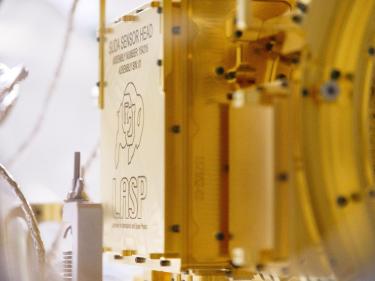
Principal investigator
Sascha Kempf

Funding
National Aeronautics and Space Administration (NASA)

Collaboration + support
JILA; Laboratory for Atmospheric and Space Physics (LASP)
Learn more about this topic:
 The Europa SUrface Dust Analyzer, developed at the Laboratory for Atmospheric and Space Physics, will investigate Jupiter’s icy moon
The Europa SUrface Dust Analyzer, developed at the Laboratory for Atmospheric and Space Physics, will investigate Jupiter’s icy moon
Next year, technology developed at CU …ęį…—«÷ř will begin a journey to Jupiter‚Äôs moon Europa‚ÄĒa cold moon where a thick crust of ice at the surface covers a potentially vast ocean of saltwater below.Őż
The more than $50 million instrument, called the Europa SUrface Dust Analyzer (SUDA), was designed and built by a team of scientists and engineers at the . It‚Äôs part of NASA‚Äôs larger Europa Clipper mission, which will investigate the icy moon to determine if it has conditions that could support life.Őż
Over seven years, roughly 150 scientists and engineers at LASP worked on the instrument, including about 40 undergraduate and graduate students. In September 2022, the team shipped SUDA to NASA‚Äôs Jet Propulsion Laboratory in Southern California, which leads the mission. SUDA and eight other scientific instruments are set to launch in October 2024 aboard the Europa Clipper spacecraft, beginning a nearly five-and-a-half-year journey to Jupiter.Őż
‚ÄúSUDA is a remarkable instrument designed and constructed by remarkable people,‚ÄĚ said LASP Director Dan Baker. ‚ÄúIt builds on our lab‚Äôs rich heritage of dust instrumentation while incorporating new technologies and techniques developed just for this mission. We can hardly wait to see SUDA‚Äôs first results.‚ÄĚŐż
The instrument‚Äôs sensor head, which is coated with an extremely thin layer of 99.99% gold, is about the size of a marching band drum and weighs nearly 35 pounds. As Europa Clipper flies past the moon, SUDA will collect and analyze particles ejected from the moon‚Äôs surface by tiny meteorites.Őż
‚ÄúWe will collect material from the surface, and we will do that without ever landing on the surface,‚ÄĚ said Sascha Kempf, principal investigator for SUDA and an associate professor at LASP and the Department of Physics.Őż
Voyage to Europa
Scientists have long had their eyes on Europa as an important target in the search for life beyond Earth.Őż
This ice-covered sphere is slightly smaller than Earth‚Äôs own moon. Underneath its miles-thick layer of ice, researchers suspect that Europa could hold more than twice the saltwater of all of Earth‚Äôs oceans combined‚ÄĒan ocean that might also carry ingredients necessary to sustain living organisms, including organic molecules like amino acids.Őż
Europa Clipper is not a life-finding mission. But it will conduct a detailed investigation of the moon and determine if those key ingredients for life are present.Őż
SUDA wouldn‚Äôt have been possible without collaboration across CU …ęį…—«÷ř. To make sure the instrument‚Äôs target could withstand impacts from dust, the LASP team partnered with researchers at to coat this disk in a thin layer of iridium‚ÄĒ one of the hardest and densest naturally-occurring metals on Earth.Őż
The hard work will pay off once SUDA and Europa Clipper make it to the icy moon in 2031. When they do, the instrument will bring a symbol of Colorado with it‚ÄĒan image of Ralphie, CU …ęį…—«÷ř‚Äôs buffalo mascot, which the SUDA team etched onto one of the instrument‚Äôs gold-plated panels using a laser.Őż
‚ÄúThe chance to be a part of the discovery of an environment capable of supporting life beyond Earth is what has kept us going through COVID and everything else,‚ÄĚ said Scott Tucker, the SUDA project manager at LASP. ‚ÄúThere‚Äôs no immediate gratification with this mission, but it‚Äôs worth it knowing that we‚Äôre going to be part of something really amazing.‚ÄĚŐż
Managed by Caltech in Pasadena, California, JPL leads the development of the Europa Clipper mission in partnership with the Johns Hopkins Applied Physics Laboratory in Laurel, Maryland, for NASA’s Science Mission Directorate in Washington, D.C. The Planetary Missions Program Office at NASA’s Marshall Space Flight Center in Huntsville, Alabama, executes program management of the Europa Clipper mission.
Photo (top): An engineer ground tests Europa Clipper‚Äôs dust analyzer. Photo byŐżNASA/CU …ęį…—«÷ř/Glenn Asakawa.